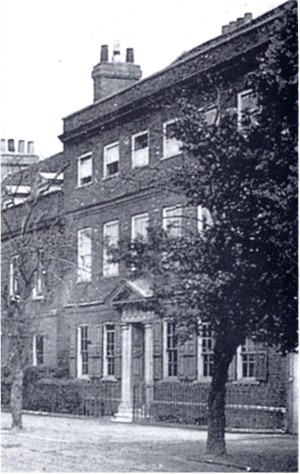
Detail from a postcard circa 1910 published in
Hoddesdon's Past in Pictures
|
Rathmore House, Hoddesdon
March, 2006
The following historic description of the house comes from J. A Tregelles' A History of Hoddesdon, published in 1908:
Next to the Cross Keys stands a house with a curious history. Of its early tenants one only (1467) need be mentioned. Walter Fader, who held it under Sir John Say, was for some time buried in Amwell Church, and it was in his grave that Shakespeare's friend William Warner was buried in 1608.It has now for many years in succession been held by doctors, and is noticeable by the most casual eye for the woodwork of the entrance doorway, a good example of what is called the Queen Anne Style - In this case 1743 and Georgian.
|
photo by Burton |
The original tenement was bequeathed by some owner, name unknown, to the Guardians of the Chapel, and was held by them for the town until the old house tumbled down in 1739. In 1743 the ground was let by the parish to John Borham, meatman, on a building lease for ninety-nine years at £1 per annum. He put up this interesting house, and his initials are interlaced in the fretwork over the door. In January, 1812, Dr. James of High Grounds being the owner, a special vestry was called to take into consideration several erasures appearing in the vestry book, in consequence of which the lease purported to have been granted for a term of 500 years instead of ninety-nine. A troublesome dispute ensued, Dr. James having bought the house in the belief that he held for the longer term. The matter was not settled for nearly three years, when it was adjusted by the help of Mr. Thomas Nicholson, steward to Lord Salisbury.
On the expiry of the original lease in 1843 the property was sold to a Mr. Stokes. The following doctors have occupied the house in succession : Locke (a descendant of John Locke), Harrison (a former partner), Gosse (who emigrated to Australia), the late Robert Ingram Stevens (1853-98), Manning, and Sturge.
The 1851 census shows William Locke, a 29 year old general practitioner born at Penzance, Cornwall, with his wife, two young children, two visitors and a resident cook, two housemaids and a groom.
H. F. Hayllar's account in The Chronicles of Hoddesdon mentions your ancestor:
No. 56, Rathmore House, is undoubtedly the finest example we have of the Georgian period, and fortunately still remains in its original condition. The workmanship is excellent throughout and well worthy of close study, especially the beautiful pointing of the brickwork round the windows, the cornice at the top and, above all, the beautiful work of the doorway. The original house tumbled down in 1739, and in 1743 the ground was let to a John Borham, a mealman, probably the son of the John Borham mentioned in Chapter Nine. He put up the present house and they are his initials that can be seen beautifully worked together with the date 1746, in the framework over the door. It is interesting to note that for practically one hundred years it has been a doctor's house, among those occupying it being Robert Stevens, who died in 1898. [No - see STEVENS, Hoddesdon, 1882-1903] I can just recollect his fine bearded, figure, always immaculately dressed in frock coat and top hat, going his rounds in a brougham with coachman. He was followed by Dr. Manning who, with my late father, was largely instrumental in starting the Hoddesdon Dispensary for the benefit of the poorer people of the town, which was still in being till the advent of the new National Health Service. Then came Dr. W. H. Sturge, a very prominent figure in the town, of whom I have given a fuller account in Chapter V. He was followed by Dr. L. West, equally prominent and well known in town affairs, also dealt with in the same chapter.
There is a passing reference in The Buildings of England: Hertfordshire.
If you contact HALS they may have other pictures in the archives.
There is a web page for Hoddesdon
If you can add to the information given above tell me.
Page link corrected October 2008